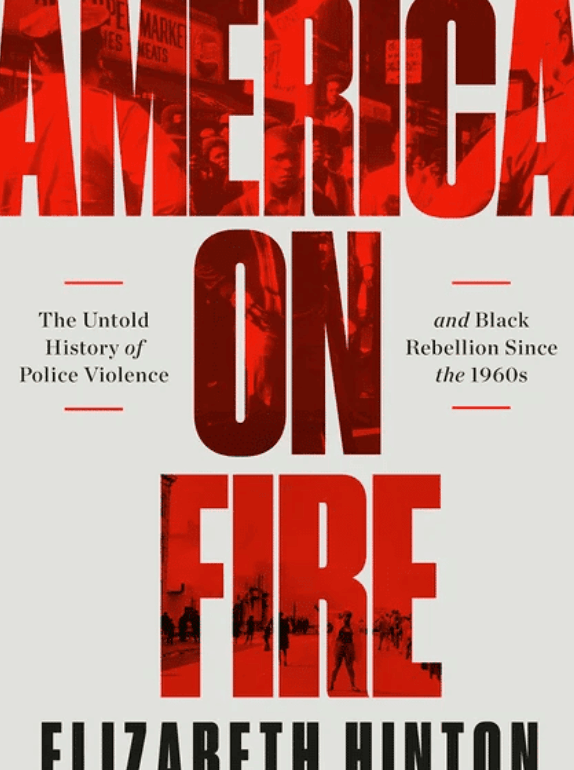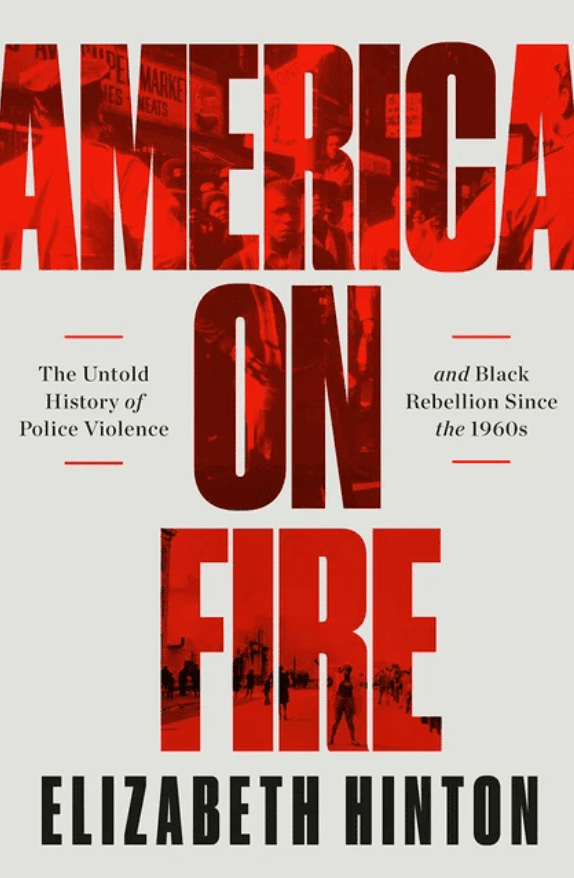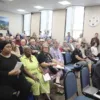Elizabeth Hinton, America on Fire: The Untold History of Police Violence and Black Rebellion Since the 1960s (New York: Liveright, 2021)
+++
Sometimes you read a book that confirms something you’d long thought but aren’t entirely sure about until you dive into the volume. That’s how I feel about the Yale history professor Elizabeth Hinton’s recent book America on Fire: The Untold History of Police Violence and Black Rebellion Since the 1960s.
Hinton’s book confirms something I’ve long suspected: the United States was struck by a remarkable and widespread wave of local Black uprisings – sociopolitical rebellions that included violent confrontations with the police and were falsely designated as mere “riots”– both within and beyond its largest cities in the months and years immediately following the assassination/execution of the great civil rights leader Dr. Martin Luther King, Jr. on April 4, 1968.
Behind my suspicion lay two things: vague childhood recollections of news stories about “riots” in various US locations beyond just the major metropolitan areas usually identified with racial violence and a later deduction about how King’s murder must have been experienced and interpreted across much of Black America. Dr. King was a leading symbol of nonviolent mass resistance. He struggled mightily to channel the struggle for Black equality onto a militant but nonviolent Christian and Gandhian path, taking heat from Black Nationalists and Black Power advocates in doing so. Along with the terribly limited material gains granted Black Americans in the whole country after the King-led Civil Rights Movement scored its historic victories over legal Jim Crow segregation and Black voter disenfranchisement in the former slave states of the US South, the murder of King surely told millions of Black folks living under conditions of savagely hyper-segregated poverty that the nonviolent approach had failed, and that more militant and even violent resistance was justified.
Professor Hinton documents the following number of Black rebellions in the US from 1964 through 1972:
1964: 4
1965: 5 (including the giant Watts rebellion in Los Angeles).
1966: 17
1967: 75 (including massive rebellions in Detroit and Newark, NJ).
1968: 504, 465 of which took place following King’s assassination/execution on April 4th
1969: 613
1970: 632
1971: 319
1972: 71
1980: 1 (Miami)
1981: 1 (Miami)
1989: 1 (Miami)
1992: 1 (the Rodney King Rebellion in Los Angeles)
There was obviously an upward “riot” trend in 1967 but the numbers take off after King was killed: there were just 140 Black rebellions from 1964 until King was murdered led four years later, compared with 1710 Black rebellions during the three and three-quarters years following his death murder.
From 1968 through 1972, Hinton notes:
“the United States endured internal violence on a scale not seen since the Civil War. Every major urban center in the country burned during those eight years. Violence flared up not only in archetypal ghettoes including Harlem and Watts, and in majority-Black cities such as Detroit and Washington, DC; it appeared in Greensboro, North Carolina, in Gary, Indiana, in Seattle, Washington, and countless places in-between – every city, small or large, where Black residents lived in segregated, unequal conditions. In the north and south, the east and the west, the rustbelt and the Sunbelt, Black people threw rocks and bottles at police, shot at them with rifles, shattered the windows of businesses and institutions, hurled firebombs, and plundered local stores” (Hinton, America on Fire, 2-3, emphasis added).
As Hinton shows, the word riot has been used as a racist trope to demean and distort what were actually sociopolitical rebellions – outbursts of Black community resistance to a violently imposed social order of racial apartheid and inequality. “What were long assumed to be Black ‘riots,’” she demonstrates, “were, in fact, Black rebellions – political acts carried out in response to an unjust and repressive society” and reflecting “the failures of the civil right era, whose unfulfilled promises resulted in continued poverty and skyrocketing imprisonment” (304).
The uprisings were a response to the persistence of systemically racist conditions that belie the common white belief that the nation has been on a great path of racial progress since the passage of the Civil Rights Act in 1964 and the Voting Rights Act in 1965.
Hinton’s seeks to rescue these uprisings not just from the label “riot” but also from connection to “the Black Panther Party…and other revolutionary groups [that] aimed to dismantle capitalism and dismantle the government.” By her telling, the Black violence reflected instead “community-based Black rebellions [that] sought redress from authorities in the form of employment, housing, education, and law enforcement, as well as a reordering of the status quo so that Black people would no longer be treated as second-class citizens in their cities and in their country.” In Hinton’s view, excessive focus on revolutionary groups as the cause of the political violence of the 1960s and 1970s has worked to “prevent an understanding of the larger, continuous, and community-based rebellions as participants of a related, but different kind of political violence of their own. Rebellion,” she argues, “served as a message to the nation that the civil rights reforms of the mid-1960s, the equal opportunity and self-help programs of the War on Poverty, and ongoing nonviolent protest were inadequate to solving the problem of racial inequality and its countless manifestations and consequences. Something else was needed” (p.8).
Much of America On Fire is dedicated to telling detailed local rebellion stories. With case studies recounting how “the [rebellion] cycle” played out in less well-known late 1960s and early 1970s “riot” zones as Stockton, California, Cairo, Illinois, Bridgeport, Connecticut, Peoria, Illinois, and York, Pennsylvania, Hinton shows that the “riots” generally followed the same basic pattern:
“An unnecessary [police-instigated] encounter between police and young Black and Brown residents, or an arrest [w]ould tip into community violence. This almost always took the form of rock-throwing, initially. In response, police reinforcements dressed in riot gear and carrying high-grade rifles financed by the federal government threw tear-gas grenades at the crowds…the rebellion would turn more violent from there, with shooting and sniping, firebombing, and arrests. The cycle could play out for multiple nights before the rebellion came to an end…, followed by some attempts, however meager, to at least look at the deeper causes” (p.45).
The efforts at grasping causation and suggesting reforms were generally conducted by “a federal, state, or local human rights commission” that yielded no serious and substantive changes in the underlying system of class-race oppression. The dominant response instead was an intensification and militarization of police state repression joined to a campaign of racist mass incarceration and felony branding – what would later become known as “the new Jim Crow.” Contrary to a liberal narrative that identifies with crackdown solely with the reactionary Republican presidency of Richard Nixon, Hinton shows that it was Nixon’s liberal predecessor Lyndon Baines Johnson who launched the racist “War on Crime” by sending militarized police forces into poor Back communities in response to the rebellions of 1966-68 – a policy that only fueled and spread “the cycle,” functioning as a self-fulfilling prophecy.
Hinton shows how “the cycle” – provocation from violent and even murderous racist police and a broader racist criminal justice system – played itself out under changed circumstances during post-1970s uprisings in Miami (1980, 1982, and 1989), Los Angeles (1992), and Cincinnati (2001). She also suggests some of the ways in which much the same basic pattern was evident in the Ferguson Rebellion of 2014 and the George Floyd-Breonna Taylor-Jacob Blake Rebellion of May-August 2020. The common thread across the last six decades is that US policymakers in both parties have chosen to criminalize, repress, and imprison masses of poor people of color rather than address underlying the socioeconomic cases of disproportionate nonwhite poverty and misery.
America on Fire is a welcome and bold corrective to dominant white Amerikan narratives on US racial violence over the last six decades. The book makes two errors, one minor and one quite serious, in this reviewer’s opinion. Hinton’s small mistake is to leave out a remarkable rebellion that took place in the current century and unfolded like something straight out of her book: a two-day June 2003 Black uprising that took place in the deeply impoverished Black ghetto of the small city of Benton Harbor, Michigan after the black motorcyclist Terrance “T-Shirt” Shurn died during an unnecessary chase undertaken by a white police officer. More than 300 state troopers and police from neighboring towns were called in to suppress the Benton Harbor “riot” with militarized riot gear. I wrote about this rebellion, which took place as I vacationed nearby, on ZNet at the time[1].
The second and more important problem is that Hinton seems to think that racial equality and justice can be achieved under US capitalism-imperialism – that America can and will stop “treating Black people as second-class citizens in their cities and in their country” without undertaking the radical transformation advocated by the late 1960s Black Panthers and the other revolutionary and anti-capitalist organizations she wants to de-link from our understanding of the rebellions she skillfully dissects.
What is to be done about the New Jim Crow and the persistence of savagely unequal American racial apartheid in 21st Century fascising Amerika, whose Christian fascist Supreme Court has recently signed on to the restoration of Jim Crow discrimination and abolished the consideration of race in college admissions? For all her seemingly militant embrace of the utility of direct action and violence against police and property during the rebellions she wonderfully “rescues from the enormous condescension of posterity” (to paraphrase the great British Marxist historian EP Thompson) and racist misrepresentation, Hinton’s concluding ideas on what is to be done seem remarkably tame: more progressive taxation to pay for expanded early childhood education, mental health, and college scholarship programs for deeply disadvantaged Black and brown communities combined with a shift in effective “crime prevention” policy from police state repression and incarceration to “programs that respond to community needs and grant control of public safety to residents, especially in areas where the state has failed.” Hinton recommends “a justice system based on repair instead of retribution” to make for “a safer society and a stronger democracy.” For Hinton, the solutions are found within the reigning order – a redistribution of resources from racist policing and mass incarceration to adequately funded schools and affordable housing, decent health care and the like. De-fund the police and prison state and boost the social democratic and racially inclusive welfare state. Down with the right and racist hand of the state and up with the left and anti-racist hand of the state.
That’s all well and good to support in one’s heart but it’s not going to happen. Amerikan capitalism-imperialism is intimately and inseparably bound up with Amerikan racism (and with Amerikan patriarchy). It cannot and will not continue without harsh racial oppression (the same is true of gender oppression). Hinton is certainly correct to note that the Black rebellions she studied emerged from more than the activism of “the Black Panther Party…and other revolutionary groups [that] aimed to dismantle capitalism and overthrow the government,” but the fact remains that we very much need to undertake a political superstructural revolution that reaches down to radically replace the capitalist mode of production with socialism if we want to achieve racial or any other kind of social justice (or environmental sanity and sustainability or freedom from continuous war) in coming years. The Panthers and other Marxist groups of the late 1960s and early 1970s , including the Maoist Revolutionary Union (RU), led by Panther ally Bob Avakian, were right: we need “to dismantle capitalism and overthrow the [capitalist-imperialist] government,” replacing it with a socialist republic. Yes, “something else was” and is “needed”: an actual revolution – the kind of thing it’s pretty damn hard if not impossible to acknowledge and fight for if you want to keep your position and status in elite academia. And that (to paraphrase Che Guevara) isn’t my fault.
Note
1. Paul Street, “‘No Justice No Peace’ – Benton Harbor And The Two Americas” by Paul Street, ZNet Magazine, June 30, 2003




